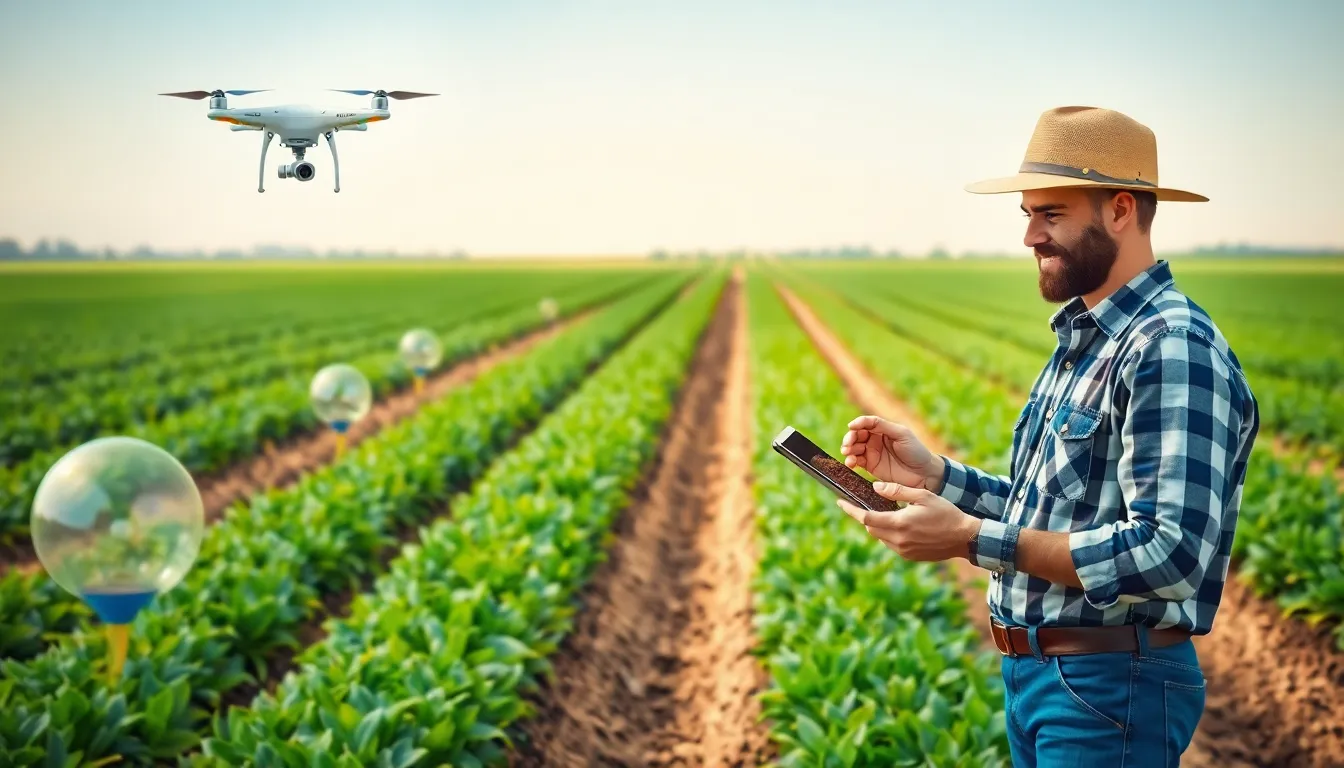Table of Contents
ToggleIn a world where food tech is the new black, innovative food science is cooking up some serious magic. Gone are the days of simply tossing ingredients together; now, it’s about using cutting-edge technologies to elevate flavors and enhance nutrition. From lab-grown burgers that taste like heaven to smart kitchens that practically cook for you, the future of food is here, and it’s deliciously exciting.
Imagine biting into a burger that not only satisfies your cravings but also helps save the planet. With advancements like 3D-printed meals and AI-driven recipes, the culinary landscape is transforming faster than you can say “foodie.” Join the journey as we explore how these emerging technologies are revolutionizing what’s on our plates, making eating not just a necessity but an adventure worth savoring.
Overview Of Innovative Food Science
Innovative food science encompasses various advancements that redefine how food is produced, prepared, and consumed. Technologies such as lab-grown protein sources contribute to more sustainable dietary options. Examples include lab-grown burgers, which replicate traditional meat but with reduced environmental impact.
Artificial intelligence plays a crucial role in developing recipes tailored to individual preferences. AI-driven systems analyze vast amounts of data, generating meals that satisfy nutritional needs while maximizing flavor. Additionally, 3D food printing technology enables the creation of intricate designs and textures, transforming food presentation.
Smart kitchen appliances integrate innovative sensors and automation, creating a seamless cooking experience. Connected devices enhance efficiency by providing real-time feedback and precise measurements. This technology allows for better meal planning and reduces food waste.
Fermentation techniques have also evolved significantly. Scientists explore novel strains of microorganisms that enhance nutritional profiles and flavor complexity. This modern approach to fermentation leads to the development of unique products, from beverages to fermented plant-based foods.
Sustainable packaging technologies emerge alongside these innovations, prioritizing eco-friendliness. Biodegradable materials and smart packaging help monitor freshness while reducing environmental impact. These advancements bolster the food supply chain by extending shelf life and minimizing spoilage.
Emphasis on health-oriented products continues to grow. Innovations such as nutrient fortification and functional ingredients cater to evolving dietary needs. Manufacturers focus on creating foods that promote wellness, reflecting an increased consumer awareness of health benefits.
By embracing these cutting-edge approaches, innovative food science reshapes culinary experiences. The convergence of technology and creativity opens opportunities for more sustainable, enjoyable, and nutritious diets.
Key Trends In Food Technology

Innovative food technology encompasses numerous trends reshaping the culinary landscape. These advancements are pivotal for sustainability and efficiency.
Precision Agriculture
Precision agriculture leverages technology to enhance crop yields and resource management. Sensors and drones gather data on soil health, moisture levels, and weather patterns, allowing farmers to make informed decisions. Implementing these technologies reduces water usage and minimizes waste while increasing productivity. Additionally, satellite imagery provides farmers with a comprehensive view of their fields, enabling targeted interventions. Farmers utilizing precision agriculture techniques often see significant enhancements in both crop quality and quantity. These practices not only promote sustainability but also bolster food security by optimizing resource use.
Alternative Proteins
Alternative proteins emerge as a key focus in food technology due to rising consumer demand for sustainable options. Lab-grown meats and plant-based proteins offer environmentally friendly solutions to traditional animal farming. These alternatives generate lower greenhouse gas emissions and require less land and water for production. Innovations in fermentation technologies enhance the flavor and texture of these products, making them more appealing to a broader audience. Companies producing alternative proteins invest heavily in research and development to improve nutritional profiles and taste. The growth of this sector reflects shifting consumer preferences toward healthier, more sustainable dietary choices.
Emerging Technologies In Food Production
Innovative technologies are reshaping food production, introducing methods that enhance efficiency and sustainability. These advancements offer unique solutions to modern culinary challenges.
3D Food Printing
3D food printing represents a groundbreaking method for creating edible structures. Chefs can design intricate shapes and textures, revolutionizing food presentation. This technology combines various ingredients through a precise layering process that minimizes waste. Nutrient-rich foods can be customized to meet dietary needs, appealing to health-conscious consumers. Examples of 3D printed products include chocolates, pasta, and even savory dishes. The ability to create complex flavors and presentations captivates chefs and consumers alike.
Lab-Grown Meat
Lab-grown meat, also known as cultured meat, signifies a major shift in protein sourcing. This innovation eliminates the need for traditional livestock farming, addressing environmental concerns associated with meat production. Cell cultures are used to grow meat in a controlled environment, providing a sustainable and humane alternative. Numerous startups are developing lab-grown options that replicate the taste and texture of conventional meat. Consumer interest continues to rise, driven by ethical considerations and health benefits. Enhanced methods of production promise a more sustainable food system, paving the way for widespread acceptance.
Sustainable Practices In Food Science
Sustainable practices in food science emphasize reducing environmental impact while enhancing food quality. Laboratory-grown proteins serve as a primary example, offering an efficient alternative to traditional meat sources. Researchers focus on methods that minimize resource usage, thereby advancing food production sustainability.
Precision agriculture employs advanced technologies, such as sensors and drones, to monitor crop health and manage resources effectively. These innovations lead to higher yields with lower inputs, benefiting both farmers and the environment. Additionally, automation in farming processes enhances efficiency, reduces waste, and ensures that crops are harvested at peak quality.
Packaging technology plays a vital role by creating eco-friendly solutions that extend shelf life and reduce spoilage. Biodegradable materials and innovative designs contribute to minimized waste in the food supply chain. Efforts to integrate sustainable packaging are essential for addressing consumer expectations for environmentally-conscious products.
Plant-based alternatives continue to gain attention as consumers seek healthier diets with less environmental impact. These products not only reduce carbon footprints but also appeal to health-conscious individuals interested in nutrient-dense options. Manufacturers invest in flavor and texture improvements to broaden the appeal of these innovative offerings.
Fermentation techniques reflect a growing trend in sustainable food practices by enhancing flavor and nutritional profiles. Fermented foods often feature improved digestibility and an array of health benefits linked to gut health. The resurgence of fermentation among chefs and home cooks alike showcases its importance in a sustainable culinary landscape.
Emerging technologies like 3D food printing streamline production while minimizing waste. Customizable meals tailored to individual dietary needs exemplify this innovation. As food science evolves, a strong emphasis on sustainable practices drives advancements that benefit consumers and the environment.
Future Directions Of Food Innovation
Innovation in food technology continues to accelerate, shaping future culinary experiences. Lab-grown proteins gain traction as ethical and sustainable options. Startups are rapidly developing these alternatives, focused on replicating the taste and texture of traditional meats. Consumer interest in plant-based diets drives demand for diverse protein sources.
Research into precision agriculture expands, utilizing drones and sensors for efficient crop management. By collecting data in real time, farmers can optimize resource usage, promoting sustainability. Automation in farming enhances productivity, ensuring higher yields with minimal environmental impact.
3D food printing is revolutionizing food preparation, offering customizable and intricate designs. Chefs can create nutrient-dense meals tailored to individual preferences, reducing food waste through precise ingredient usage. This technique supports a shift toward more efficient production methods.
Additionally, advancements in fermentation reveal new possibilities for flavor enhancement and nutritional benefits. Traditional methods combine with modern technology, resulting in innovative products that meet health-conscious consumers’ needs. As awareness of wellness grows, manufacturers focus on functional ingredients and nutrient fortification.
Eco-friendly packaging solutions are also becoming a priority, emphasizing biodegradable and recyclable materials. These innovations contribute to extending shelf life while minimizing landfill waste. Meeting consumer expectations for sustainable products aligns with the overall push for environmental responsibility within the industry.
Future developments in food innovation emphasize sustainability, efficiency, and health. Combining technology with culinary creativity will continually reshape food experiences, leading to a more enjoyable and nutritious landscape.
The future of food is bright and full of possibilities. Innovative food science and emerging technologies are not just enhancing culinary experiences but also addressing critical issues like sustainability and nutrition. As consumers become more conscious of their choices they’ll likely embrace these advancements that prioritize health and environmental responsibility.
From lab-grown proteins to smart kitchen appliances the culinary landscape is evolving rapidly. This transformation invites everyone to explore new flavors and healthier options while contributing to a more sustainable food system. As technology continues to advance the journey towards a more innovative and responsible food future is just beginning.




